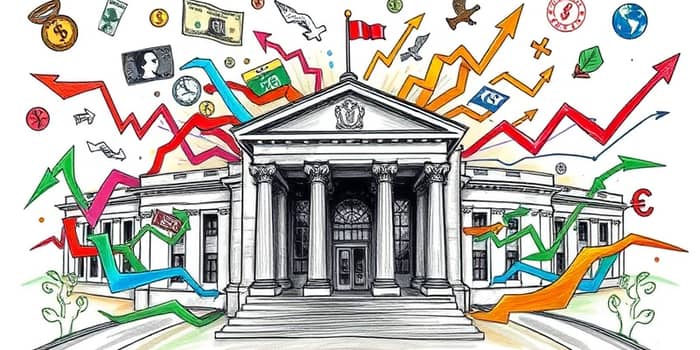
Global financial markets in 2025 have been on a rollercoaster, responding rapidly to shifts in monetary policy. Investors, policymakers, and analysts alike are watching every move from the Federal Reserve and European Central Bank to gauge the health of economies and the direction of risk appetite. This article explores how recent policy decisions shape global risk sentiment and what lies ahead.
Following years of aggressive rate hikes aimed at reining in inflation, major central banks are now pivoting toward easing. This shift carries profound implications for asset prices, volatility, and capital flows worldwide.
After peaking at 5.50% in mid-2024, the Fed funds rate has been cut to the 4.50%–4.75% range. The ECB’s deposit rate fell from 4.00% to 3.25% in its June meeting. These moves signal a transition from a extended period of tightening toward a more balanced stance.
Market consensus expects further cuts as both central banks seek a neutral policy rate. Estimates place that neutral range at 2.75%–3.25% for the US and 1.50%–2.50% for the euro area. Reaching these thresholds could allow economies to grow without reigniting inflation.
However, achieving the delicate balance between growth and price stability remains challenging. Energy price volatility, lingering supply-chain disruptions, and geopolitical risks continue to cloud the outlook. Central banks stress that any future adjustments will be data dependent, underscoring the importance of labor market indicators and core inflation trends.
Policy decisions ripple through the global financial system via multiple channels. Markets digest both the immediate rate change and the accompanying forward guidance, which often has an even greater impact on investor expectations.
Central banks now place strong emphasis on managing expectations. By offering projections for future rate paths and balance sheet adjustments, they aim to reduce market surprises. Yet, overreliance on messaging carries the risk of self-reinforcing market reactions as traders amplify any perceived signals.
In early 2025, trade policy uncertainty soared. Reciprocal tariffs announced in April triggered the most pronounced volatility since the pandemic. Global equities experienced sharp sell-offs, credit spreads widened, and even the typically resilient US dollar depreciated in a rare display of unusual safe haven dynamics.
As tariff threats subsided, markets staged a rebound. Equity indices recovered initial losses, high-yield credit spreads narrowed, and risk appetite returned, underscoring how sensitive sentiment has become to both monetary and trade policy shifts.
Credit markets have also displayed acute sensitivity. Investment-grade and high-yield spreads widened sharply in risk-off episodes, then tightened once central banks reaffirmed their easing bias.
Different asset classes respond uniquely to policy signals:
These dynamics illustrate how policy shifts can trigger broad rebalancing across portfolios. Investors must navigate a landscape where duration, credit risk, and currency exposure all hinge on central bank actions.
Looking ahead, several factors could amplify or moderate the influence of central bank policy:
1. Lag effects: Monetary adjustments typically take time to impact employment and inflation. Markets may overshoot as they front-run data releases.
2. Geopolitical shocks: Renewed trade tensions or military conflicts could override monetary signals, forcing central banks to reconsider their paths.
3. Fiscal sustainability: Rising long-term yields in the US reflect concerns over government debt, which could constrain future easing capacity.
Central banks must remain vigilant against complacency. While easing can support growth, too much accommodation risks reigniting inflationary pressures. Clear, credible communication will be crucial to maintaining confidence without sparking unnecessary volatility.
Investors, in turn, should incorporate central bank guidance into their strategic planning, but avoid overreacting to every hint in policy statements. A balanced approach—anchoring portfolios in diversified risk factors and monitoring real economic indicators—can help navigate the twists and turns of global monetary policy in 2025 and beyond.
Ultimately, central banks retain a pivotal role as guardians of financial stability. Their decisions will continue to shape market sentiment and asset valuations, underscoring the inseparable link between policy and global risk appetite.
References













